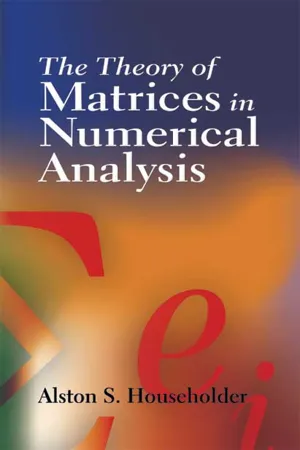
This is a test
- 272 pages
- English
- ePUB (mobile friendly)
- Available on iOS & Android
eBook - ePub
The Theory of Matrices in Numerical Analysis
Book details
Book preview
Table of contents
Citations
About This Book
This text explores aspects of matrix theory that are most useful in developing and appraising computational methods for solving systems of linear equations and for finding characteristic roots. Suitable for advanced undergraduates and graduate students, it assumes an understanding of the general principles of matrix algebra, including the Cayley-Hamilton theorem, characteristic roots and vectors, and linear dependence.
An introductory chapter covers the Lanczos algorithm, orthogonal polynomials, and determinantal identities. Succeeding chapters examine norms, bounds, and convergence; localization theorems and other inequalities; and methods of solving systems of linear equations. The final chapters illustrate the mathematical principles underlying linear equations and their interrelationships. Topics include methods of successive approximation, direct methods of inversion, normalization and reduction of the matrix, and proper values and vectors. Each chapter concludes with a helpful set of references and problems.
An introductory chapter covers the Lanczos algorithm, orthogonal polynomials, and determinantal identities. Succeeding chapters examine norms, bounds, and convergence; localization theorems and other inequalities; and methods of solving systems of linear equations. The final chapters illustrate the mathematical principles underlying linear equations and their interrelationships. Topics include methods of successive approximation, direct methods of inversion, normalization and reduction of the matrix, and proper values and vectors. Each chapter concludes with a helpful set of references and problems.
Frequently asked questions
At the moment all of our mobile-responsive ePub books are available to download via the app. Most of our PDFs are also available to download and we're working on making the final remaining ones downloadable now. Learn more here.
Both plans give you full access to the library and all of Perlego’s features. The only differences are the price and subscription period: With the annual plan you’ll save around 30% compared to 12 months on the monthly plan.
We are an online textbook subscription service, where you can get access to an entire online library for less than the price of a single book per month. With over 1 million books across 1000+ topics, we’ve got you covered! Learn more here.
Look out for the read-aloud symbol on your next book to see if you can listen to it. The read-aloud tool reads text aloud for you, highlighting the text as it is being read. You can pause it, speed it up and slow it down. Learn more here.
Yes, you can access The Theory of Matrices in Numerical Analysis by Alston S. Householder in PDF and/or ePUB format, as well as other popular books in Mathematics & Algebra. We have over one million books available in our catalogue for you to explore.
Information
CHAPTER 1
Some Basic Identities and Inequalities
1.0. Objectives; Notation. In this chapter and the next will be developed some of the basic tools and relations that will be utilized repeatedly in subsequent chapters. At the outset a matrix of quite simple form will be introduced. It is the result of subtracting a matrix of rank 1 at most from the identity matrix, and any matrix of this form will be called here an “elementary matrix.” Such matrices will play a fundamental role in inversion, and also in the reduction of a matrix by similarity transformations to facilitate the evaluation of its characteristic roots. These will be applied immediately to obtain certain factorization theorems, which are of basic importance both for inversion and for equation solving.
The method of least squares can be interpreted geometrically as the projection of an arbitrary given vector upon a certain subspace; and each step in certain iterative methods can likewise be interpreted as a projection. Hence a general form of a projection operator will be obtained, and the formation of this operator makes some use of the factorization theorems just, obtained. A further application of the factorization theorems will be made in the following section, where certain classical determinantal identities and inequalities will be derived. These will be required in the analysis and derivation of certain iterative methods, and also for more general theoretical considerations.
In the last two sections of this chapter will be introduced certain polynomials associated with an arbitrary matrix and vector. One class is defined by an algorithm due to Lanczos who introduced it originally as a first step toward finding the characteristic values and vectors of a matrix; indeed, the algorithm is much used for this purpose. But the same algorithm occurs in the method of conjugate ...
Table of contents
- Title Page
- Copyright Page
- Dedication
- Preface
- Table of Contents
- CHAPTER 1 - Some Basic Identities and Inequalities
- CHAPTER 2 - Norms, Bounds, and Convergence
- CHAPTER 3 - Localization Theorems and Other Inequalities
- CHAPTER 4 - The Solution of Linear Systems: Methods of Successive Approximation
- CHAPTER 5 - Direct Methods of Inversion
- CHAPTER 6 - Proper Values and Vectors: Normalization and Reduction of the Matrix
- CHAPTER 7 - Proper Values and Vectors: Successive Approximation
- Bibliography
- Index